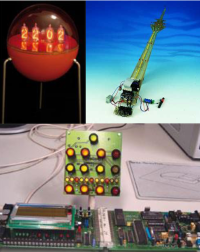Back in time with the Sputnik time machine, Berlin clock and Rhine Tower clock

Elektor's clock galary / museum. Which clock to you like most? Sputnik Time Machine
Elektor's clock galary / museum. Which clock to you like most?
Sputnik Time Machine
Nostalgia and microcontroller technology merged in a single design Sputnik Time Machine Sputnik 1, the first artificial satellite, was launched in 1957. It captured the attention of the entire world with the eerie beeps it transmitted, which could be received by radio amateurs everywhere in the world. Fifty years after this historic event, it seems fitting to build a clock in the shape of the Sputnik satellite that combines a nostalgic Nixie tube display with a modern microcontroller. Technology has changed a lot in recent decades. Launching a satellite that simply transmitted a beep signal was a major achievement in 1957, but now we routinely put satellites into orbit that can transmit hundreds of television channels. This design uses a combination of modern and old-fashioned technology. The shape of the Sputnik and the Nixie tubes are elements of old-fashioned technology, while the low-loss switching regulators for the supply voltages and the microcontroller-based control logic are examples of modern technology.
Berlin Clock
Remake using the SPI bus Berlin Clock In the world of unusual timepieces one example stands out: the Berlin clock, which has been showing the time since 1975 using an ever-changing pattern of lights. Our version imitates the original using an LED display controlled over an SPI bus.
Rhine Tower clock Mk II
a special design, with a circuit board shaped like the tower Rhine Tower clock Mk II The DCF-controlled LED clock design, published in the May 1998 issue of Elektor Electronics, is a radio-controlled electronic version of the clock mounted on the Rhine Tower in Düsseldorf. Inspired by the many positive reactions to this project, its designer has reworked the software to add new features. To make things even nicer, Elektor Electronics has designed a special circuit board in the shape of the actual tower in Düsseldorf.Building a circuit yourself is even more pleasant when the result is something unique. Those of you that have built the original DCF-controlled LED clock will certainly have experienced this first-hand. Anyone who sees such a clock for the first time will undoubtedly wonder what it is and how it works.The clock that is integrated into Düsseldorf’s Rhine Tower consists of a series of lights arranged in a vertical line. The 39 lamps that are used to indicate the time on the tower are replaced in this project by yellow LEDs.



Discussion (0 comments)